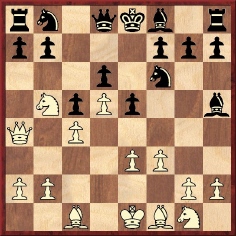
Edward Winter
In this odds game between James A. Leonard and his brother, White’s play was ‘a text-book example of the power of the double check’ (Kurt Richter):

9 Nxd6+ Ke7 10 Nf5 mate.
Below are two specimens in which a dragnet is set up by the move Qxg7+, followed by a powerful double check:
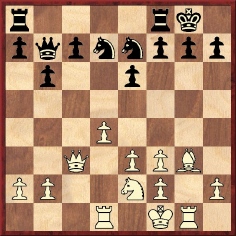
White to move
Vane-Miles, Sydney, 1897
1 d5 Nxd5 2 Qxg7+ Kxg7 3 Be5+ Kh6 4 Bg7+ Kh5 5 Rxd5+ f5 6 Nf4+ Kh4 7 Rg4+ fxg4 8 Rh5 mate.
Source: Deutsches Wochenschach, 19 December 1897, page 467.
C.S. Anderson – Schneider
Brooklyn, 1908
Hungarian Defence
1 e4 e5 2 Nf3 Nc6 3 Bc4 Be7 4 O-O Nf6 5 Nc3 d6 6 h3 O-O 7 d4 exd4 8 Nxd4 Bd7 9 Qd3 h6 10 Qg3 Kh7 (10...Nxd4 wins.) 11 Qd3 Kh8 12 b3 Nh7 13 f4 Na5 14 Bb2 Nxc4 15 bxc4 Qc8 16 Nd5 Qd8 17 Qg3 Bh4
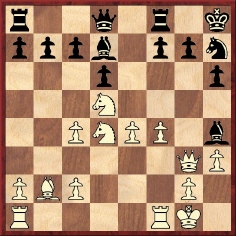
18 Qxg7+ Kxg7 19 Nf5+ Kg6 20 Nxh4+ Qxh4 21 f5+ Bxf5 22 exf5+ Kh5 23 g4+ Qxg4+ 24 hxg4+ Kxg4 25 Rf4+ Kg3 26 Raf1 Ng5 27 Bd4 Nh3+ 28 Kh1 Nxf4 29 Rxf4 Resigns.
Source: American Chess Bulletin, September 1908, page 191.
(Chess Café, 1998)
From a game won by V. Place (against ‘N.L.’) at the Café de la Régence, Paris in January 1922 (given in The Chess Seesaw):

1 Nxg7 Kxg7 2 d5 Bg4 3 Rxf6 Bxd1 4 Rg6+ Kh7 5 Rg7+ Kh8 6 Rh7+ Kg8 7 Rh8 mate.
Source: La Stratégie, May 1922, page 113.
(2838)
S. Lurie and E. Wagenheim – J. Bastin and O. Bolotow
Riga, 8 and 9 April 1898
Evans Gambit Accepted
1 e4 e5 2 Nf3 Nc6 3 Bc4 Bc5 4 b4 Bxb4 5 c3 Bd6 6 d4 Nf6 7 Bb5 Qe7 8 O-O O-O 9 Re1 h6 10 c4 Bb4 11 Re2 Nxd4 12 Nxd4 exd4 13 e5 Nh7 14 Qxd4 c6 15 Ba4 d6 16 Bb2 dxe5 17 Rxe5 Qd6 18 Qe3 Nf6 19 c5 Qd8 20 Qf4 Ba5 21 Na3 Bc7 22 Nc4 Nd5 23 Qg3 f6 24 Rxd5 cxd5 25 Nd6 Qe7 26 Bb3 Qe6 27 Rd1 Qe2 28 Bc3 Kh8 29 Qg6 Qg4 30 Nf7+ Rxf7 31 Qxf7 Bd7 32 Bc2 Bc6 33 Bxf6 d4 34 g3 Rg8 35 Re1 Qh3 36 Re4 gxf6
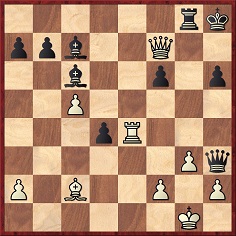
37 Qh7+ Kxh7 38 Re7+ Kh8 39 Rh7 mate.
Source: Baltische Schachblätter, Heft 11, 1908, pages 17-19.
(3137)
See too Réti v Tartakower, Vienna, 1910 and Anderssen v Dufresne: The Evergreen Game.
Defining double check is tricky if all eventualities are to be covered. Some attempts are quoted here.
Fred Reinfeld, on page 83 of 1001 Brilliant Chess Sacrifices and Combinations (New York, 1955):
‘Of all the different kinds of discovered check, the double check is the most dangerous and the most menacing. For here the ‘discovering’ piece not only uncovers a check; by moving, it gives a direct check.’
Edward R. Brace, on page 83 of An illustrated Dictionary of Chess (London, 1977):
‘A simultaneous check from two men. This occurs only when one man moves and checks at the same time uncovering a piece which also gives check …’
Wolfgang Heidenfeld, writing on page 88 of The Encyclopedia of Chess by Harry Golombek (London, 1977):
‘A discovered check in which both pieces check the hostile king …’
Nathan Divinsky, on page 56 of The Batsford Chess Encyclopedia (London, 1990):
‘A discovered check in which both pieces check the enemy king …’
John Emms, on page 283 of Concise Chess (London, 2003):
‘This is a special version of the discovered check. It occurs when a piece moves off a line (a file, rank or diagonal) to give check, uncovering another check from a different piece behind it on the same line.’
Readers are invited to consider those passages in the light of White’s second move in the position below (which was discussed by D.J. Morgan on page 203 of the August 1957 BCM – see also Chess Life, 20 March 1954):
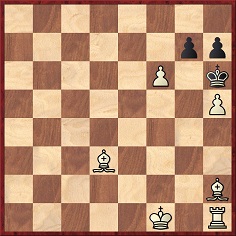
White to move
White wins with 1 Bf4+ g5 2 hxg6 mate.
(3138)
See also En passant (Chess).
A further definition comes from page 248 of The Chess Player’s Bible by James Eade (Hauppauge, 2004):
‘Double check A discovered check when the moving piece also delivers a check.’
To the position given in C.N. 3138 may be added the following, submitted by Jim Walsh to CHESS, 15 April 1960 (page 236):
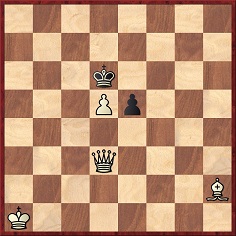
‘Black’s last was ...e5. White replies dxe6 delivering double check without the pawn itself checking.’
On the same page of the magazine the task of constructing a double-check position without any move by a checking piece was described by Wolfgang Heidenfeld as follows: ‘This is easy by using the e.p. capture and has been shown frequently.’ Nonetheless, as noted in C.N. 3138, Heidenfeld himself wrote on page 88 of The Encyclopedia of Chess by H. Golombek (London, 1977) that double check was ‘A discovered check in which both pieces check the hostile king …’
(3485)
Alexander Steinkühler – Bernhard Horwitz
Manchester (date?)
Petroff Defence
1 e4 e5 2 Nf3 Nf6 3 Nxe5 Nxe4 4 Qe2 Qe7 5 Qxe4 d6 6 d4 Nd7 7 f4 f6 8 Be2 fxe5 9 fxe5 dxe5 10 O-O exd4 11 Bh5+ Kd8 12 Bg5 Nf6 13 Rxf6 Qxe4 14 Rd6 mate.
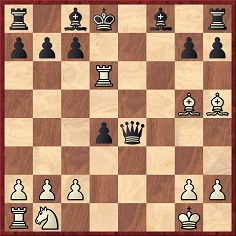
Source: the Chess Player’s Magazine, 1863, page 125.
A very similar game (won by Ossip Bernstein at queen’s rook odds in Paris, 1931 against an unnamed opponent) was published on, for instance, pages 111-112 of Chernev’s 1000 Best Short Games of Chess:
1 e4 e5 2 Nf3 Nf6 3 Nxe5 Nxe4 4 Qe2 Qe7 5 Qxe4 d6 6 d4 f6 7 f4 Nd7 8 Bc4 fxe5 9 fxe5 dxe5 10 O-O exd4 11 Bf7+ Kd8 12 Bg5 Nf6 13 Rxf6 Qxe4 14 Rd6 mate.
(3275)
Frederick S. Rhine (Park Ridge, IL, USA) draws attention to page 197 of Complete Defense to King Pawn Openings by Eric Schiller (New York, 1998), concerning the game is Ghinda v W. Watson, Thessaloniki, 1988:
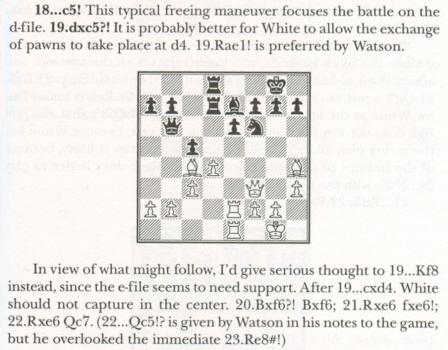
The position after 22 Rxe6:
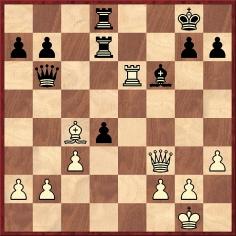
Schiller observes that Watson’s suggestion 22...Qc5 allows 23 Re8 mate. So, instead, Schiller recommends 22...Qc7, overlooking that it allows 23 Re8 mate.
(6281)
From page 7 of The Brilliant Touch by Walter Korn (London, 1950):
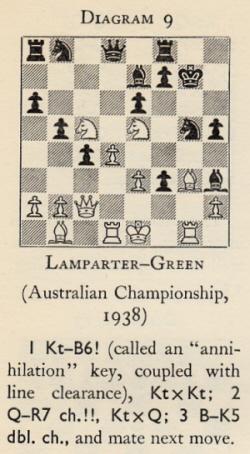
Further information is sought about this position, which was also shown by Irving Chernev on pages 12-13 of Combinations The Heart of Chess (New York, 1960):
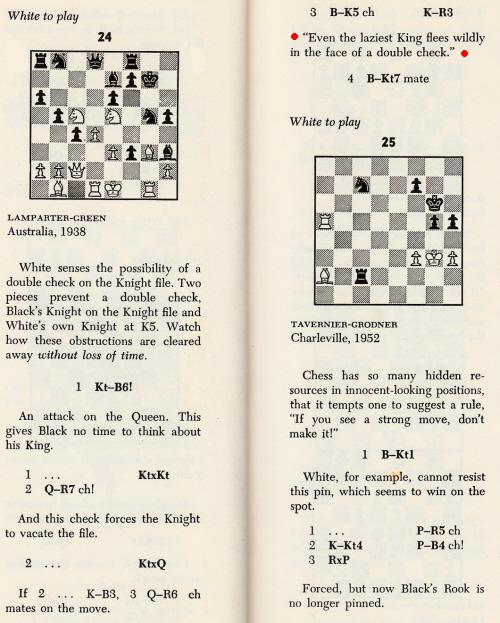
Concerning the note after 3...Kh6, it is unclear why Chernev did not mention that ‘Even the laziest king flees wildly in the face of a double check’ was a remark by Nimzowitsch. Chernev knew it, having given the attribution in an article on the inside front cover of Chess Review, November 1954:
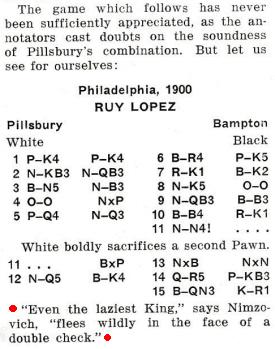
The full Pillsbury v Bampton feature was reproduced on pages 200-201 of Chernev’s book The Chess Companion (New York, 1968), and the position at move 13, when the black king flees from the threat of double check, may seem a better illustration than the Lamparter v Green position.
The remark appeared in My System, in the chapter on discovered check; page numbers vary according to the edition. On page 146 of the 2007 translation published by Quality Chess the text was:
‘Even the most sluggish king will panic – driven to flight after a double check.’
In the original of Nimzowitsch’s work, Mein System (Berlin, 1925), the passage was on page 156:
‘Selbst der trägeste König greift angesichts eines Doppelschachs zur wildesten Flucht.’
Whether a ‘perfect’ version of Nimzowitsch’s remark can be made is doubtful, but a curious point is that whereas the English translation from the 1920s (‘Even the laziest king flees wildly in the face of a double check’) is frequently quoted in books and articles, though usually without an exact reference, the original German text is seldom cited anywhere.
(8652)
Christian Sánchez (Rosario, Argentina) has found the full Lamparter v Green game on page 50 of the 28 May 1938 issue of the Australasian:
George R. Lamparter – Martin Green
Victorian Championship, Melbourne, May 1938
Queen’s Gambit Declined
1 d4 Nf6 2 c4 e6 3 Nf3 d5 4 Bg5 h6 5 Bh4 Be7 6 Nc3 a6 7 e3 O-O 8 Bd3 dxc4 9 Bxc4 c5 10 Qe2 b5 11 Bb3 c4 12 Bc2 Bb7 13 Rd1 g5 14 Bg3 g4 15 Ne5 Bxg2 16 Rg1 Bh3 17 Bb1 h5 18 Qc2 Kg7 19 Ne4 Nh7 20 Nc5 Ng5 21 f4 gxf3 22 Nc6 Nxc6
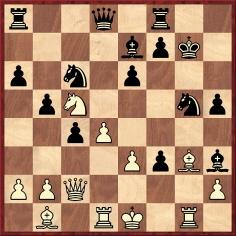
23 Qh7+. (‘Mate in three moves.’)
(8655)
Regarding the familiar quotation ‘Discovered check is the dive-bomber of the chess board’, the exact wording on page 112 of Chess The Easy Way by Reuben Fine (Philadelphia, 1942) was:
‘Discovered check. This is one of the most destructive devices that anybody can think up – it is the dive-bomber of the chess board.’
A variant appeared on page 15 of Fine’s The Middle Game in Chess (Philadelphia, 1952):
‘Discovered check. This is one of the most destructive devices available to the player – it is the hydrogen bomb of the chessboard.’
(8726)
See also C.N. 9548.
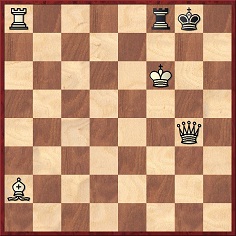
White gives mate without making any move
(9022)
This is one of two compositions by Arthur John Curnock (‘one of the foremost Metropolitan amateurs’) on page 538 of the December 1902 BCM. The solution was published on page 141 of the March 1903 issue:
‘It is obvious Black has just played an illegal move. White compels him to retrace his move in order to comply with the rules of the game. It will be seen that as White is in check, Black’s rook must have last moved, and also as Black is in double check the king also must have moved, therefore Black must have illegally castled. Replace the pieces and it is found that Black is mated without White having to make a move.’
(9032)
To the Chess Notes main page.
To the Archives for other feature articles.
Copyright: Edward Winter. All rights reserved.